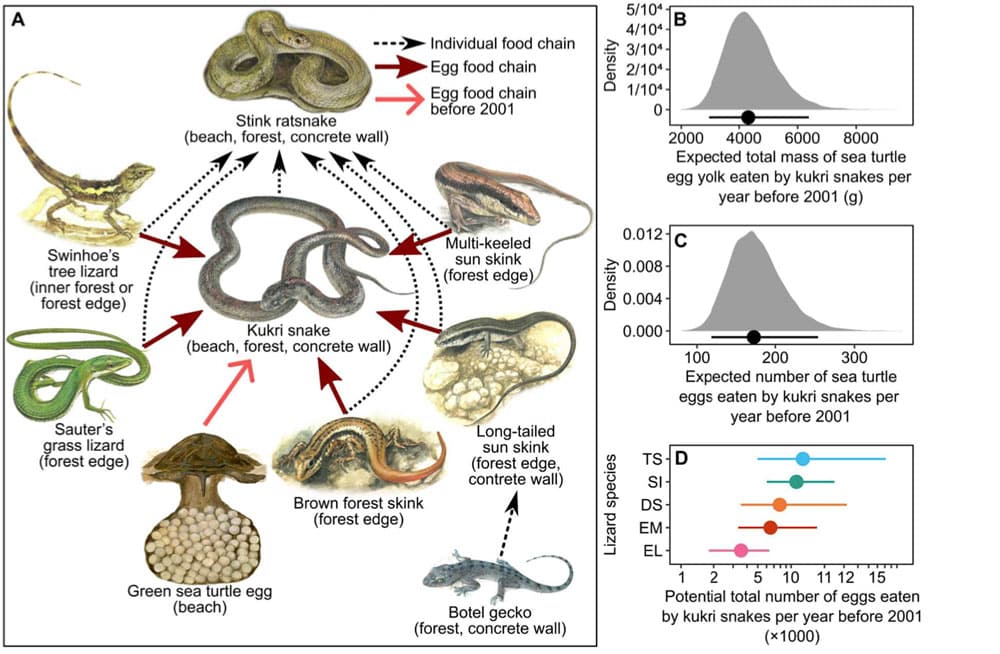Beach erosion and the erection of fencing to prevent snakes from entering sea turtle nest areas caused the decline of lizard species on Orchid Island in Taiwan.
The practice of protecting sea turtle nests to prevent predation from other animals is apparently having a negative effect on reptiles that eat the sea turtle eggs as part of their diets. This is according to researchers studying the effects of egg protection on Orchid Island in southeast Taiwan. The researchers from the University of Taipei, National Taiwan University, National Chung Hsing University and San Diego State University studied the Orchid Island ecosystem for 23 years, including a site that provided them with data on “key members of the terrestrial community before and after the loss of sea turtle eggs as a nutrient subsidy.”
Two reptiles on Orchid Island, the reptile egg-eating kukri snake (Oligodon formosanus) and the stink rat snake (Elaphe carinata) a generalist predator that is the top predator of the island regularly fed on sea turtle eggs from the green sea turtle (Chelonia mydas). The eggs were an abundant source of food for these two snake species, until beach erosion combined with the protecting of sea turtle nests from predators were practiced. The erosion, combined with strong storms in 2001 caused the beaches in which the turtles nested to become unsuitable for nesting. Coupled with the launch of predator exclusion practices in 1997 and the finalizing of a fine mesh plastic fencing structure as a solution to protect all the nests, resulted in the elimination of sea turtle eggs from the terrestrial food web.

The reptile food web on Orchid Island and the importance of sea turtle eggs in the context of egg predation by kukri snakes. (A) Trophic links between reptile species, with egg predation shown by red arrows and predation on hatched individuals shown by black arrows. For species that nest in particular habitats, nesting habitat is given parenthetically after species name. (B) Estimated mass and (C) number of sea turtle eggs consumed annually by kukri snakes from 1997 to 2000 at Tungching Beach; (D) sea turtle egg mass consumed by kukri snake expressed as the equivalent number of lizard eggs for five lizard species. DS, Diploderma swinhonis, Swinhoe’s tree lizard; EL, Eutropis longicaudata, ling-tailed sun skink; EM, Eutropis multicarinata, multi-keeled sun skink; SI, Sphenomorphus incognitus, brown forest skink; TS, Takydromus sauteri, Sauter’s grass lizard.
This change in environment caused these snakes to rely more heavily on eggs from other native lizards on the island, including the Swinhoe’s tree lizard (Diploderma swinhonis), Sauter’s grass lizard (Takydromus sauteri), multi-keeled sun skink (Eutropis multicarinata), long-tailed sun skink (Eutropis longicaudata), and the brown forest skink (Sphenomorphus incognitus). The Botel gecko (Gekko kikuchii) eggs were not predated by the kukri snake.
The researchers observed an uptick in attacks on the lizard clutches of these species, except the Botel gecko, as well as a decline in the population of these lizards that coincided with the beach erosion and the protection of sea turtle nests on the island. This shift in predatory behaviors of the snakes, combined with increasing human development and more intense storms caused by climate change, rising sea levels and invasive species shows a causal relationship between lack of access of the sea turtle eggs and the declines of the native lizard species on the island. The researchers noted that populations of these lizards that lack large kukri snake populations remained robust during the same time frame as the beach erosion event and the introduction of the fine mesh plastic fencing.
“Our study suggests that sea turtle eggs provided a critical subsidy to the terrestrial ecosystem of Orchid Island, supporting large populations of kukri snakes and stink ratsnakes, and when this subsidy was removed, these snakes shifted into other habitats for alternative prey, perhaps driving the widespread decline of those lizard species vulnerable to egg predation,” the researchers wrote in their paler.
The study, “Loss of sea turtle eggs drives the collapse of an insular reptile community,” can be read on the Science Advances website.

